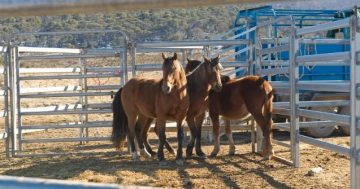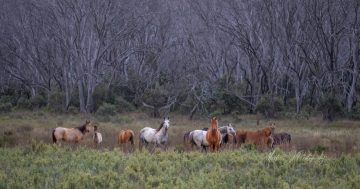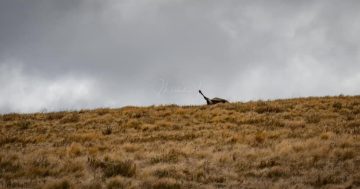
Claire Rogerson is a custodian of the brumby way of life, passing on her training knowledge of the wild horses to people willing to take on mobs. Photo: Claire Rogerson.
Just a couple of weeks ago Claire Rogerson fielded a phone call asking for her brumbies to feature in an advertisement for a car company.
Soon thereafter the Dalgety-based horsewoman tasked two of her horses to repeatedly gallop a short course through snow between cameras and a Hyundai vehicle – which they happily did – with the extra benefit of winning a bunch of new admirers.
But what happened behind the scenes, with a young foal Claire took along for the ride, was more remarkable.
“The film crew were just blown away by Bluey the foal who just wandered around the set happily chilling while the other two horses did numerous runs alongside the car,” Claire said. “Afterwards, during beers at the pub, they asked for his backstory, and when I told them, they said that had to be a news story.”
Well, Bluey was a news story some time ago. Rescued from Kosciuszko National Park (KNP) in April 2023 as culling of wild horses commenced, the small orphan foal was last seen bundled up in a car as part of a desperate attempt to save his life.
Now the not-so-small Bluey is the furry third face of Claire’s brumby training enterprise – Snowy Mountain Horsemanship – leading Claire’s brumby mob in from their huge mountain reserve for work each day.
“I first met Bluey when I was camping up at Wares Yards up in the mountains,” Claire said. “He was found alone in the park and rescued, brought back to the yards and amid the many discussions about what to do next, Bluey whinnied and one of my brumbies Sammy walked over to him and they haven’t been parted since.”
From a bush block on the Snowy River, Snowy Mountain Horsemanship exclusively trains brumbies and for Claire there’s no two ways about it, these horses need a dedicated program to transition them to domestic life.
“What people don’t realise when they take on brumbies is that at some stage they will need to be handled, whether that be trimming their feet, dental work, worming, or gelding, and particularly if they require veterinary attention,” Claire said. “And all too often I get calls from people in all sorts of trouble who don’t know where to begin.”

Bluey the foal always follows along behind Claire and Sammy when they ride out. Photo: Claire Rogerson.
She’ll be the first to tell you she’s never trained a domestic horse, but the former outdoor wilderness teacher became the student when she took on a brumby after purchasing her land 15 years ago.
“I had no idea about horses at all but I wanted a horse to keep my son’s pony company,” she said. “When I got Sammy and she was being loaded onto the float I was saying, ‘I don’t know what I’m doing’, but the man said to me, ‘She will teach you and you will teach her’ and that’s how it started.”
Not even knowing how to fit a saddle and bridle, she started by walking Sammy in the bush and, bit by bit, learned more about what worked and didn’t work for her.
She credits Sammy and another brumby called Sunny, “her right and left hands” with running the show at the registered not-for-profit charity.
There are 23 brumbies in training – of all ages, from all over the country – some straight from the wild, some needing a second chance which, when ready, are transported and transitioned over, at no cost, to live in preapproved sanctuaries with mobs already selected by Claire.
As a brumby custodian, she is critically aware an uncommon touch is needed to ensure their wellbeing.
“Like all horses these are mob animals, but brumbies have their own language, which is entirely different from domestic horses,” she said, “so you can’t treat them the same way.”
The process of guiding the once-wild horses to accept simple handling becomes a contract for life, which means continued general care, including property visitations up to four times a year to trim their feet.
“We’re not like most people in the brumby world as we don’t class ourselves as ‘rehomers’, instead I am a trainer of the once-wild horses,” she said. “I have dedicated myself, my home, my own land, my days, my own money and my conscience to all brumbies who come here for their transition into a successful domestic life.”
She also educates people about brumbies, and anyone with over 200 acres of bushland keen to take mobs on, through private lessons or weekends held at Dalgety and throughout the capital region, with one set down for the October long weekend at Hall Showground.
Amid demonstrations and wild horse training workshops, there’ll be lessons on saddlery, river crossing, bush riding, hobble training, join up and liberty work, whip cracking and roping all against a backdrop of a true bush experience of campfires and food.
For Claire this isn’t about business – it is about promoting, showcasing, and celebrating the legend and culture of the brumby.
“There’s a lot of misinformation floating around out there about brumbies and this gives people the opportunity to actually see them – we don’t get into the politics of it all – but what we do want to see is a better outcome for the horses that are leaving the park,” she said.
For more information on Claire’s programs visit Snowy Brumby Horsemanship.
















